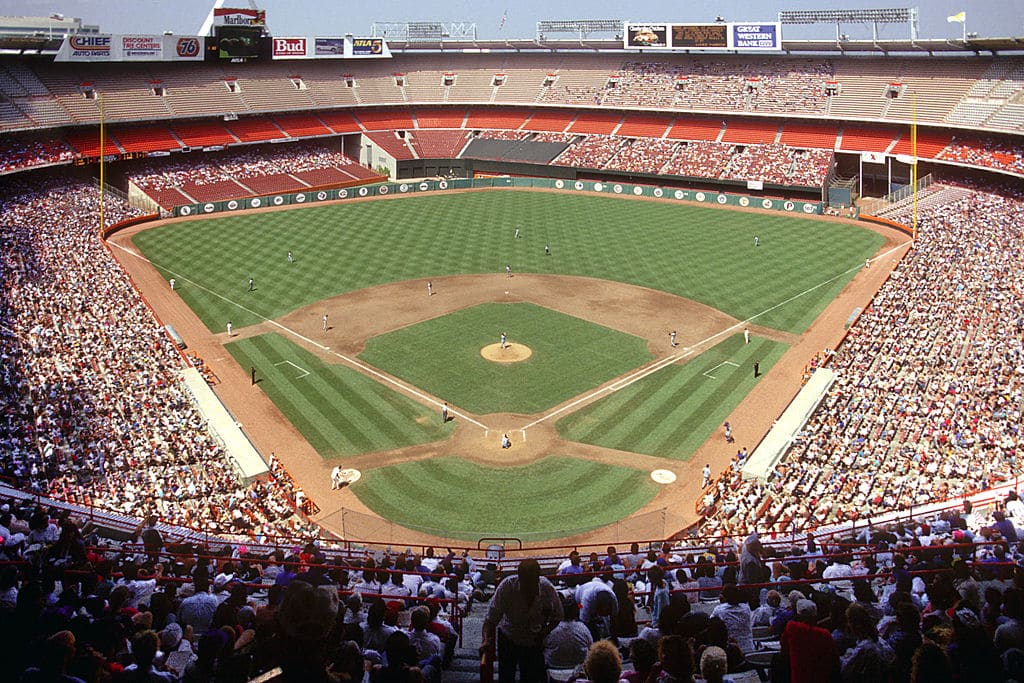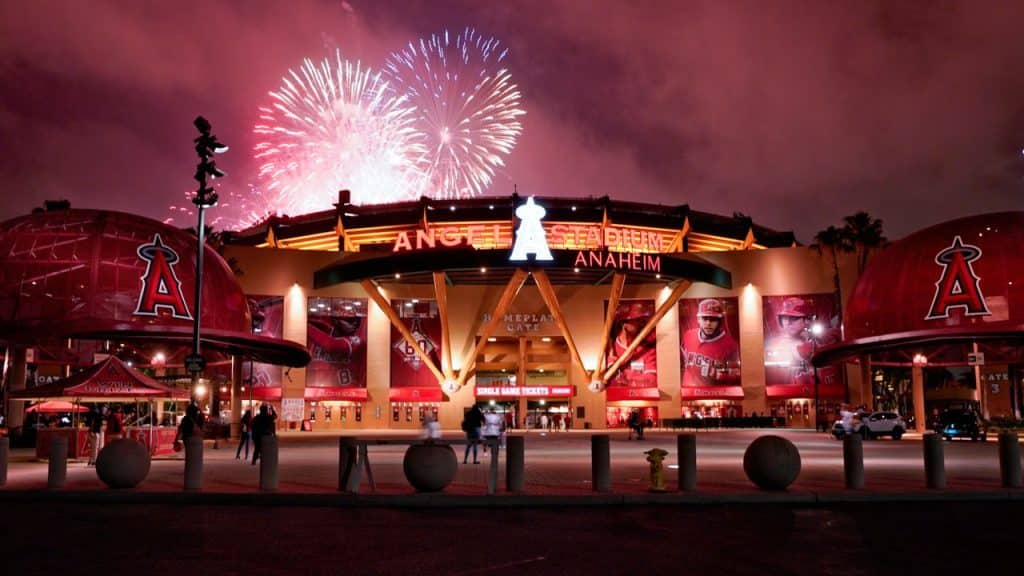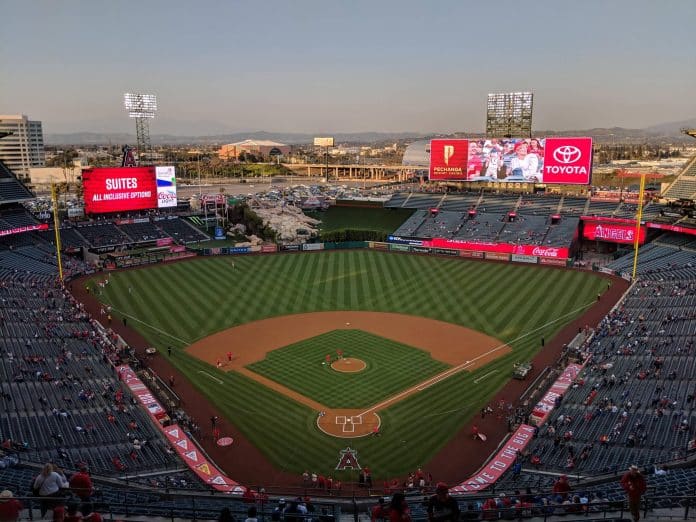Angels Stadium Seating Chart details you should know before buying a ticket.
Angel Stadium of Anaheim is a top-notch venue located in Anaheim, California. As many fans will attest to, Angel Stadium of Anaheim is known to be one of the best places to catch live entertainment around town. The Angel Stadium of Anaheim is known for hosting the Los Angeles Angels but other events have taken place here as well.

Angel Stadium Seating Maps
SeatGeek is known for its best-in-class interactive maps that make finding the perfect seat simple. Our “View from Seat” previews allow fans to see what their view at Angel Stadium seating will look like before making a purchase, which takes the guesswork out of buying tickets.
To help make the buying decision even easier, we display a ticket Deal Score on every row of the map to rate the best bargains.
We also try to provide you as many seating charts/seat maps as we can, because each one can be a little different. You can browse the various Angel Stadium of Anaheim seating charts/seat maps by scrolling up top and choosing one from the list.

Angel Stadium Seating Chart
Angel Stadium of Anaheim, originally known as Anaheim Stadium, later Edison International Field of Anaheim, and commonly referred to as just Angel Stadium, is a baseball stadium located in Anaheim, California.
Since its opening 56 years ago in 1966, it has served as the home ballpark of the Los Angeles Angels of Major League Baseball (MLB), and was also the home stadium to the Los Angeles Rams of the National Football League (NFL) from 1980 to 1994.
The stadium is often referred to by its unofficial nickname The Big A, coined by Herald Examiner Sports Editor, Bud Furillo. It is the fourth-oldest active ballpark in the majors, behind Fenway Park, Wrigley Field, and Dodger Stadium,[5] and hosted the All-Star Game in 1967, 1989, and 2010.
ARTIC (Anaheim Regional Transportation Intermodal Center) servicing the Metrolink Orange County Line and Amtrak Pacific Surfliner, is located nearby on the other side of the State Route 57 and accessed through the Douglass Road gate at the northeast corner of the parking lot.
The station provides convenient access to the stadium, the nearby Honda Center, and Disneyland from various communities along the route, which links San Luis Obispo, Los Angeles, and San Diego. The Anaheim Resort Transit stops at the center along with Orange County Transportation Authority buses.
Aside from professional baseball and football, Angel Stadium has hosted high school and college football games, the short-lived World Football League, two crusades by evangelist Billy Graham, nearly 20 consecutive annual crusades by evangelist Greg Laurie, Eid el Fitr celebrations, and concerts, and 2 to 3 AMA Supercross Championship races a year.
The stadium also houses the studios and offices of the Angels’ owned and operated flagship radio station, KLAA (830 AM).
Location and Big A
Angel Stadium and its surrounding parking lot are roughly bounded by Katella Avenue to the north, the Orange Freeway to the east, Orangewood Avenue to the south, and State College Boulevard to the west.
The landmark “Big A” sign, which originally served as a scoreboard support in left field, is located near the eastern boundary of the parking lot. The halo located near the top of the 230-foot (70 m) tall, 210-ton sign is illuminated following games in which the Angels win (both at home and on the road). Broadcaster Victor Rojas would refer to the halo by saying “Light that baby up!” after a victory.

History of Angel Stadium
Angel Stadium has been the home of the Angels since their move from Los Angeles. On August 31, 1964, ground was broken for Anaheim Stadium, and in 1966, the then-California Angels moved into their new home after having spent four seasons renting Dodger Stadium (referred to in Angels games as Chavez Ravine Stadium) from the Dodgers.
The stadium was built on a parcel of about 160 acres (0.65 km2) of flat land originally used for agricultural purposes by the Allec, Russell, and Knutzen families in the southeast portion of Anaheim. Consistent with many major-league sports stadiums built in the 1960s, it is located in a suburban area, though one that is host to major tourist attractions.
The field dimensions (333 feet instead of 347 or 350, for example) were derived from a scientific study conducted by the Angels. Based on the air density at normal game times (1:30 pm and 8 pm), the Angels tried to formulate dimensions that were fairly balanced between pitcher, hitter, and average weather conditions.
The Angels tinkered with those dimensions several times, expanding or contracting parts of the outfield by a few feet here and there, to try to refine that balance. 396 feet (120.7 m) is the shortest center-field in the American League, and tied for 3rd-shortest in the major leagues with Petco Park behind only Oracle Park’s 391 feet (119.2 m) & Dodger Stadium at 395 ft (120.4 m).
None of this seemed to matter to their Hall of Fame pitcher Nolan Ryan, who threw two of his record seven no-hitters in this ballpark, and racked up 2,416 of his 5,714 career strikeouts in eight seasons with the Angels (Ryan stats from The Sporting News Baseball Record Book).
One of the no-hitters, on June 1, 1975, was his fourth, which tied Sandy Koufax’s career record, one Ryan would eventually surpass with seven by the end of his career in 1993.

The Rams move in
In the late 1970s, Los Angeles Rams owner Carroll Rosenbloom was looking for a more modern venue than the Los Angeles Memorial Coliseum, and also wanted a stadium that would be small enough to keep Rams games from being blacked out on local television.
The Coliseum seated almost 100.000 people, and the Rams had trouble filling it even in their best years. Rosenbloom brokered a deal by which the Rams would move from Los Angeles to an expanded Anaheim Stadium.
To add more seats (eventually about 23,000) for football games, the mezzanine and upper decks were extended completely around the playing field, resulting in a roughly trapezoidal, completely enclosed stadium.
An elevated bank of bleachers was built in right field, and temporary seats were placed underneath, to be pulled out for football games. Another bank of bleachers was built in left field. As a result, the view of the local mountains and State Highway 57 was lost.
Additionally, the Big A scoreboard support that stood in left field, and was the inspiration for the stadium’s nickname, was moved 1,300 feet (395 m) to its present site in the parking lot, adjoining the Orange Freeway beyond the right-field stands; its usage changed from scoreboard to electronic marquee advertising upcoming events at the stadium.
A black and amber scoreboard/instant replay video board was installed above the newly constructed upper deck seats in left field. Swift technical innovations in scoreboards in the 1980s quickly made the 1979 display obsolete, and the visual quality was washed out during day games as it was in direct sunshine, thus in 1988, a Sony Jumbotron color board replaced it, with amber matrix displays installed about the right field upper deck and along the infield balcony. A triangular metal spire was added to the top of the Jumbotron to evoke the original emplacement of the “Big A”.
As with the addition of football seats to Candlestick Park a decade before to accommodate the rival San Francisco 49ers, the changes would be to the disadvantage of the Angels, their fans, and the stadium atmosphere. No seat was further than 109 feet (33 m) from the field when first designed for baseball.
However, as was the case nearly everywhere else where the multipurpose stadium concept was tried, most of the new center field seats were too far from the action. Also, while the expanded capacity allowed the Angels to set attendance records that still stand today, on most occasions even crowds of 40,000 left swaths of unusable and empty seats.
It also didn’t completely solve the television blackout issue which inspired the Rams to move from the Coliseum, as the stadium would not sell out if the Rams weren’t competitive or the opposing team did not draw their own fans to Anaheim to sell out the game.
The expansion was completed in time for the 1980 NFL season, and the Rams played in Anaheim Stadium from then until their move to St. Louis after the 1994 season. The Rams would return to Los Angeles in 2016, playing their games at the Memorial Coliseum again for four seasons; the team is now moved into SoFi Stadium.
The January 17, 1994 Northridge earthquake on Martin Luther King Jr. Day caused the left-field Jumbotron to collapse onto the upper deck seats beneath it. As the Rams and Angels were both out of season and it occurred in the pre-dawn hours, nobody was injured.
The damaged section was deconstructed and rebuilt with a new scoreboard structure and Jumbotron, eliminating the A-frame spire that evoked the Big A.

The Disney era
In 1996, The Walt Disney Company, a minority owner of the team since its inception (the stadium is located less than 3 miles (5 km) east of Disneyland and across from the Honda Center, the home venue of the then Disney-owned Mighty Ducks of Anaheim), gained enough support on the board to effectively take control of the team.
Soon afterward, the Angels and the city of Anaheim agreed to a new deal that would keep the Angels in Anaheim until 2031, with an option to leave the facility after the 2016 season. As part of the deal, the stadium underwent an extensive renovation, returning the stadium to its original role as a baseball-only facility.
Before the 1997 baseball season, the section behind the outfield wall was demolished. Disney briefly considered moving the Big A scoreboard to its original location, but decided against such a move, citing costs, as well as the fact that the Big A had become a Southern California landmark in its parking lot location.
Despite the fact that much of the stadium was still a hard-hat zone, the demolition and construction being only half-completed, the Angels played their 1997 season in Anaheim. Fans were greeted by a restored view of the San Gabriel and Santa Ana Mountains, the Brea Hills, and the 57 freeway beyond the outfield.
Work that didn’t interfere with game play continued throughout the 1997 season, with major renovations resuming in the winter of 1997.
These included the installation of outfield bleacher pavilions, a video display board and an out-of-town scoreboard below the right field seats. All of the multicolored seats were replaced by green seats.
The exterior of the stadium was also renovated. The concrete structure and ramps were painted a combination of green and sandstone. Much of the facade of the stadium was torn down to create a more open feeling for visitors.
The most notable feature of the entire renovation, however, was a “California Spectacular” in which geysers erupt and a stream cascades down a mountainside (Pride Rock) covered with real trees, artificial rocks behind the left-center field fence, and new bullpens.
Fireworks shoot out of the display at the start of games, after every Angel home run and after every Angel win (they had been shot off from a parking garage before then).
The field dimensions of the renovated stadium became somewhat asymmetrical, with the 8-foot (2.4 m) high fence in right center field (which earlier hid the football-only bleacher section) replaced by a 19-foot (5.8 m) high wall which contains a scoreboard displaying out-of-town scores of other games.
A plaza was built around the perimeter of the stadium, and inside are statues depicting longtime Angel owner and chairman Gene Autry and Michelle Carew, daughter of former Angel Rod Carew, who died of leukemia at the age of 18.
The main entrance includes two giant Angels hats complete with New Era tags on the sweatband (including one indicating the hats’ size: 649½). The hats were originally blue and featured the Angels’ “winged” logo designed by Disney for the 1997 season, and were repainted red and decorated with the present-day halo insignia for the 2002 season.
Also outside home plate gate is a full-sized brick infield complete with regulation pitcher’s mound and lighted bases, with bricks at each player position engraved with the names of Angels players who played at that position on Opening Day of each season since the Angels began play in 1961. For a fee, the green infield bricks can be engraved with fans’ names or personalized messages.
The Angels opened their “new” stadium on April 1, 1998, with a 4–1 victory over the New York Yankees. The renovated stadium has 5,075 club seats and 78 luxury suites.
In 1998, the stadium was renamed Edison International Field of Anaheim after local utility Edison International reached a deal giving it naming rights over the stadium for 20 years, and during this time, the stadium was referred to as the “Big Ed”.
However, after the 2003 season, Edison International exercised its option to exit the sponsorship deal. On December 29, 2003, the Angels announced that from then on the stadium would be known as Angel Stadium (in full, Angel Stadium of Anaheim); Disney sold the Angels around this time as well. After the name change in 2004, its original nickname, “The Big A”, was restored again.

Video improvements and cancelled sale
In 2009, Brookings, South Dakota-based Daktronics installed light emitting diode (LED) displays at the stadium. The largest video display measures 41 ft (12.50 m) high by 67 ft (20.42 m) wide. Two smaller displays flank the large display, and a field-level display sits in the centerfield fence.
The stadium will host baseball and softball at the 2028 Summer Olympics.
During the 2017-2018 offseason, the Angels upgraded the existing video boards in left and right field. The new left field video board measures 5,488 sq ft (509.9 m2), while the new right field board measures 9,500 sq ft (880 m2), the fourth largest scoreboard in MLB.
In addition to this, the out of town scoreboard was upgraded, new video ribbons stretch from foul pole to foul pole, and a new sound system was added. Because of the new out of town scoreboard, the Angels moved the home run line in right field down from 18 feet (5.5 m) to 8 feet (2.4 m), though the height of the right field wall remains the same.
The Angels opted out of their lease in October 2018, largely to avoid a contractual provision which would have forced them to remain in the stadium until 2029, though the club then had no new stadium proposals or moving plans.
In December 2019, the city of Anaheim agreed to sell the stadium and surrounding land to an Arte Moreno-affiliated management company for $325 million, with the team committed to remain in Anaheim until at least 2050, with options to remain until at least 2065.
The deal, made behind closed doors, has led to allegations of corruption and violations of the state’s Surplus Land Act.
An ongoing FBI investigation into the city’s internal affairs and the stadium sale eventually led to the resignation of Anaheim mayor Harry Sidhu on May 23, 2022, putting the stadium’s pending sale into question. On May 24, 2022, the Anaheim City Council voted to cancel the sale to Moreno’s SRB Management, in light of the corruption probe.
Notable sport events
The stadium was host to the 1967 MLB All-Star Game, the first All-Star Game to be played on prime-time television. This was the first time an All-Star Game was held at night since World War II. Angel Stadium again hosted All-Star Games in 1989 and 2010.
It hosted seven American League Division Series (2002, 2004, 2005, 2007, 2008, 2009, and 2014) and six American League Championship Series (1979, 1982, 1986, 2002, 2005, and 2009).
Most notably, it hosted the 2002 World Series, which the Angels won in dramatic fashion over the San Francisco Giants, finally winning one for their late and long-time owner, “Singing Cowboy” Gene Autry (and for his widow and business partner, Jackie, who is also honorary president of the American League).
Angel Stadium hosted several games during Round 2 of the 2006 World Baseball Classic.
Famous individual baseball milestones attained here include Mickey Mantle’s last game-winning home run, Nolan Ryan’s striking out of nine straight Boston Red Sox (and two of Nolan Ryan’s seven no-hitters), Reggie Jackson’s 500th career home run, Rod Carew’s 3,000th career base hit, Don Sutton’s 300th career win, Vladimir Guerrero’s 400th career home run, George Brett’s 3,000th career base hit, and Albert Pujols’ 600th career home run.
On Saturday, August 9, 2014, the stadium hosted its longest game ever: a 6-hour, 31-minute contest between the Angels and the Boston Red Sox. Albert Pujols led off the batting in the bottom of the 19th inning with a walk-off homer, giving the Angels the win, 5–4.[
The stadium is currently designated to host softball and baseball events for the 2028 Summer Olympics along with Dodger Stadium.



